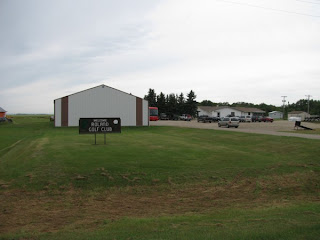Yesterday’s journey to the International Peace Gardens that straddles the border between the United States of America and the Socialist People’s Republic of Manitoba began bright and early with a bus trip downtown to the pickup point at the Holiday Inn turned Red River Hotel turned back to Holiday Inn.
Of course, I was early, as was our bus, so I got on as Roswitha, our tour guide once again, went into the hotel. While waiting, one of the other passengers got on and, unsure of where to sit, took her place next to me and asked if I worked for the tour company. I’ve been with them so often that I probably could do the job if called upon, but I politely answered that I was a fellow customer.
After the last pickup point at Salisbury House on Pembina Highway, with all 37 passengers aboard, we set out for the Peace Gardens, a place I had not visited since I was a young child.
On our way, we passed through Brunkild:
… then through Carman:
Rather than taking us to a sizable population center for our morning stop, we were instead escorted a mile down a country gravel road, Road 22W to be precise, for a visit to the Roland Golf Club.
In any event, I wasn’t the only person who noticed one of the male golfers teeing up while wearing a red dress.
After departing the Roland Golf Club, still contemplating how the tour company found this place, or why they would make such effort to do so, Harold, our bus driver, took us for a tour of the nearby town of Roland. Of particular note was the town icon, a giant pumpkin:
There we were in the middle of nowhere while I kept recalling Jesse Ventura’s line from Predator, “If you lose it here, you’re in a world of hurt.”
We were in a world of hurt.
After doing her best to entertain her passengers and passengerettes, Roswitha went out and flagged down a passing motorist who was kind enough to take Harold to nearby Miami and back, bringing with them a shiny, new bolt that cost the princely sum of $1.50. It wasn’t the time to make a joke that Orlando might have been closer.
Before the motorist who took Harold to Miami left, someone from our tour who was outside thanked him and gave him some money for his trouble. I hope that the bus company does likewise. It was very nice of him to stop and spend the time and effort to help us, and I would also like to thank him for his generosity.
It didn’t take long for Harold to put in the new bolt and in short order, after being on the side of the highway for an hour and a half, we were again heading west.
They decided to take PTH 23 since it was a more scenic route and one of the most noteworthy sights was the wind farm near St. Leon.
This is the approach to Ninette, easily the most scenic spot on this route. In the background is Pelican Lake.
Minutes later, we reached the entrance to the Peace Gardens. Ahead is the U.S. Customs office.
En route to the Peace Chapel, I took some more shots.
The bell tower:
I would come back often if I lived nearby, but for an all-day event like this, I’m not sure that it’s worth a return trip any time soon.
After leaving the Peace Gardens, we had to go back through customs.
A border guard came out to meet the bus and, to my shock, he appeared to be over the age of 18. He asked a couple of questions and sent us on our way without asking to see passports.
We continued north along PTH 10, then turned to go east at PTH 2, travelling on a route I last saw a year ago when I visited Souris on a day tour. The afternoon/evening stop was Treherne, perhaps the most inappropriately named town in Manitoba. Since the town is on highway number two, not “tree”, the name “Twoherne” might be a better choice.
Winding up a long and adventurous day, we returned back to the degenerate capital of the Socialist People’s Republic of Manitoba, where I disembarked at my dropoff point downtown. The punks and weirdos were just starting to emerge from the cracks and crevasses and I suspect that in another hour, I would have been in the middle of a real-life scene from Escape from New York. Fortunately, I got home on a Transit bus without incident, but not without delay as, once again, a city resident got on a bus asking the driver if the bus goes to a particular address. With all the information on the city and the transit system so readily available at your fingertips, it continues to astound me why some people use buses as mobile tourist information booths rather than doing a little work themselves. If the city is going to put all the information out there for you, the least you can do is go look for it.
My thanks to Harold, for a job well done, not just in bringing us there and back safely, but for his repair work in the middle of nowhere. For a while there, it was beginning to look like the only peace garden we were going to see yesterday was the tranquil field were parked alongside of. The fact that we saw the real peace gardens was also due in no small measure to the motorist from Morden who pulled over and answered our call of distress, and to him go my thanks as well. Finally, another round of thanks for Roswitha, whom I’ve had as a tour guide for the fifth time in as many weeks.











































No comments:
Post a Comment